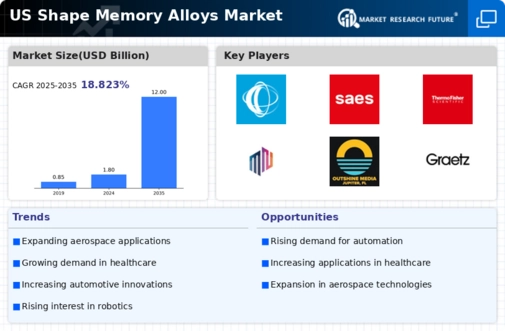The shape memory alloys market exhibits a dynamic competitive landscape characterized by innovation and strategic partnerships. Key players such as Johnson Matthey (US), SAES Getters (US), and Fort Wayne Metals (US) are actively shaping the market through their distinct operational focuses. Johnson Matthey (US) emphasizes sustainability and advanced manufacturing techniques, positioning itself as a leader in environmentally friendly solutions. Meanwhile, SAES Getters (US) has concentrated on expanding its product portfolio, particularly in the medical sector, which appears to be a significant growth driver. Fort Wayne Metals (US) focuses on enhancing its supply chain capabilities, ensuring reliability and efficiency in delivering high-quality products. Collectively, these strategies foster a competitive environment that prioritizes innovation and responsiveness to market demands.
The business tactics employed by these companies reflect a trend towards localizing manufacturing and optimizing supply chains. The market structure is moderately fragmented, with several players vying for market share. However, the influence of major companies is pronounced, as they leverage their resources to establish a competitive edge. This fragmentation allows for niche players to thrive, yet the overarching strategies of the key players dictate the market's direction.
In November 2025, Johnson Matthey (US) announced a partnership with a leading aerospace manufacturer to develop advanced shape memory alloys for use in next-generation aircraft components. This collaboration is strategically significant as it not only enhances Johnson Matthey's technological capabilities but also positions the company at the forefront of aerospace innovation, potentially leading to increased market share in a high-value sector.
In October 2025, SAES Getters (US) launched a new line of shape memory alloys specifically designed for minimally invasive surgical applications. This move underscores the company's commitment to the medical field and reflects a growing trend towards specialized applications of shape memory alloys. By addressing the unique needs of the healthcare sector, SAES Getters (US) is likely to capture a larger share of this lucrative market segment.
In September 2025, Fort Wayne Metals (US) expanded its manufacturing facility in Indiana, investing $5 million to enhance production capabilities for shape memory alloys. This expansion is indicative of the company's strategy to meet increasing demand and improve operational efficiency. By bolstering its manufacturing capacity, Fort Wayne Metals (US) positions itself to better serve its customers and respond to market fluctuations.
As of December 2025, current competitive trends in the shape memory alloys market include a pronounced focus on digitalization, sustainability, and the integration of AI technologies. Strategic alliances are increasingly shaping the landscape, enabling companies to pool resources and expertise. Looking ahead, competitive differentiation is expected to evolve, with a shift from price-based competition to a greater emphasis on innovation, technological advancements, and supply chain reliability. This transition suggests that companies that prioritize these elements will likely emerge as leaders in the market.

















Leave a Comment